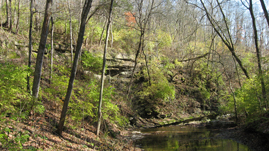Teachers' Domain - Digital Media for the Classroom and Professional Development
User: Preview


Blood River is an example of a “coastal plain forested acid seep” community. A seep is an area where the flow of water downhill through sand and gravel forms pools at the bottom. The unique biomes found in such an area, make it home to some very rare species. Adapted from the Kentucky Life Biodiversity series, this video offers information about the diversity of the region
The Blood River region is located on a 193-acre preserve in southwestern Kentucky, along the Tennessee border. Blood River is a unique example of a “coastal plain forested acid seep” community.
A seep is a unique type of wetland. In a seep, water flows downhill over hardwood forest slopes, and down through sand and gravel. The groundwater then flows to the surface at the bottom to form pools.
The aquatic communities that form in these semi-permanent bodies of water depend on these unique types of habitats to survive. Rare species known to occur along the Blood River include the gray bat, central mudminnow, Western mud snake, three lined salamander, threadleaf mock bishop–weed, sweetscent ladies’ tresses and Nuttall’s oak. Blood River is also an area known for its rare amphibians.
From great blue herons to the Blood River crayfish, the area is one of the richest biodiverse regions in the state.
The Blood River seeps State Nature Preserve and the Blood River system are considered one of the most biologically diverse areas you can find in Kentucky. It is about 192 acres. It was purchased for the coastal plains acid seeps, but it also encompasses uh bottom land forest, subxeric acid forest, and Tupelo slews.
There is a variety of habitats here so you kind of create a hot spot of biodiversity allowing for more species to be found here because of all those systems being here together. Seeps are a type of wetlands. Wetlands are nature’s water filter. They take up pollutants and cycle them out. They purify your water.
What makes a seep a seep is water going through sand and gravel, and then in this area it is coming down at the base of the hill, and it flows down through this acid seep system into the bottom land hardwood forest. Only two percent of Kentucky’s land is is wetland and most of it is right here.
 Loading Standards
Loading Standards